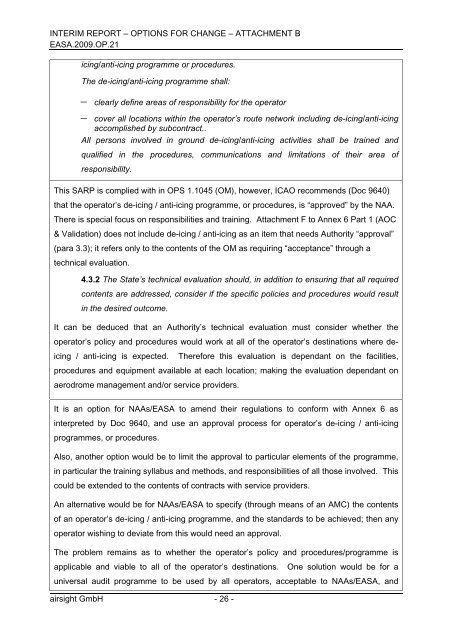Interim Report - Introduction - EASA
Interim Report - Introduction - EASA
Interim Report - Introduction - EASA
You also want an ePaper? Increase the reach of your titles
YUMPU automatically turns print PDFs into web optimized ePapers that Google loves.
INTERIM REPORT – OPTIONS FOR CHANGE – ATTACHMENT B<br />
<strong>EASA</strong>.2009.OP.21<br />
icing/anti-icing programme or procedures.<br />
The de-icing/anti-icing programme shall:<br />
− clearly define areas of responsibility for the operator<br />
− cover all locations within the operator’s route network including de-icing/anti-icing<br />
accomplished by subcontract..<br />
All persons involved in ground de-icing/anti-icing activities shall be trained and<br />
qualified in the procedures, communications and limitations of their area of<br />
responsibility.<br />
This SARP is complied with in OPS 1.1045 (OM), however, ICAO recommends (Doc 9640)<br />
that the operator’s de-icing / anti-icing programme, or procedures, is “approved” by the NAA.<br />
There is special focus on responsibilities and training. Attachment F to Annex 6 Part 1 (AOC<br />
& Validation) does not include de-icing / anti-icing as an item that needs Authority “approval”<br />
(para 3.3); it refers only to the contents of the OM as requiring “acceptance” through a<br />
technical evaluation.<br />
4.3.2 The State’s technical evaluation should, in addition to ensuring that all required<br />
contents are addressed, consider if the specific policies and procedures would result<br />
in the desired outcome.<br />
It can be deduced that an Authority’s technical evaluation must consider whether the<br />
operator’s policy and procedures would work at all of the operator’s destinations where deicing<br />
/ anti-icing is expected. Therefore this evaluation is dependant on the facilities,<br />
procedures and equipment available at each location; making the evaluation dependant on<br />
aerodrome management and/or service providers.<br />
It is an option for NAAs/<strong>EASA</strong> to amend their regulations to conform with Annex 6 as<br />
interpreted by Doc 9640, and use an approval process for operator’s de-icing / anti-icing<br />
programmes, or procedures.<br />
Also, another option would be to limit the approval to particular elements of the programme,<br />
in particular the training syllabus and methods, and responsibilities of all those involved. This<br />
could be extended to the contents of contracts with service providers.<br />
An alternative would be for NAAs/<strong>EASA</strong> to specify (through means of an AMC) the contents<br />
of an operator’s de-icing / anti-icing programme, and the standards to be achieved; then any<br />
operator wishing to deviate from this would need an approval.<br />
The problem remains as to whether the operator’s policy and procedures/programme is<br />
applicable and viable to all of the operator’s destinations. One solution would be for a<br />
universal audit programme to be used by all operators, acceptable to NAAs/<strong>EASA</strong>, and<br />
airsight GmbH - 26 -

















